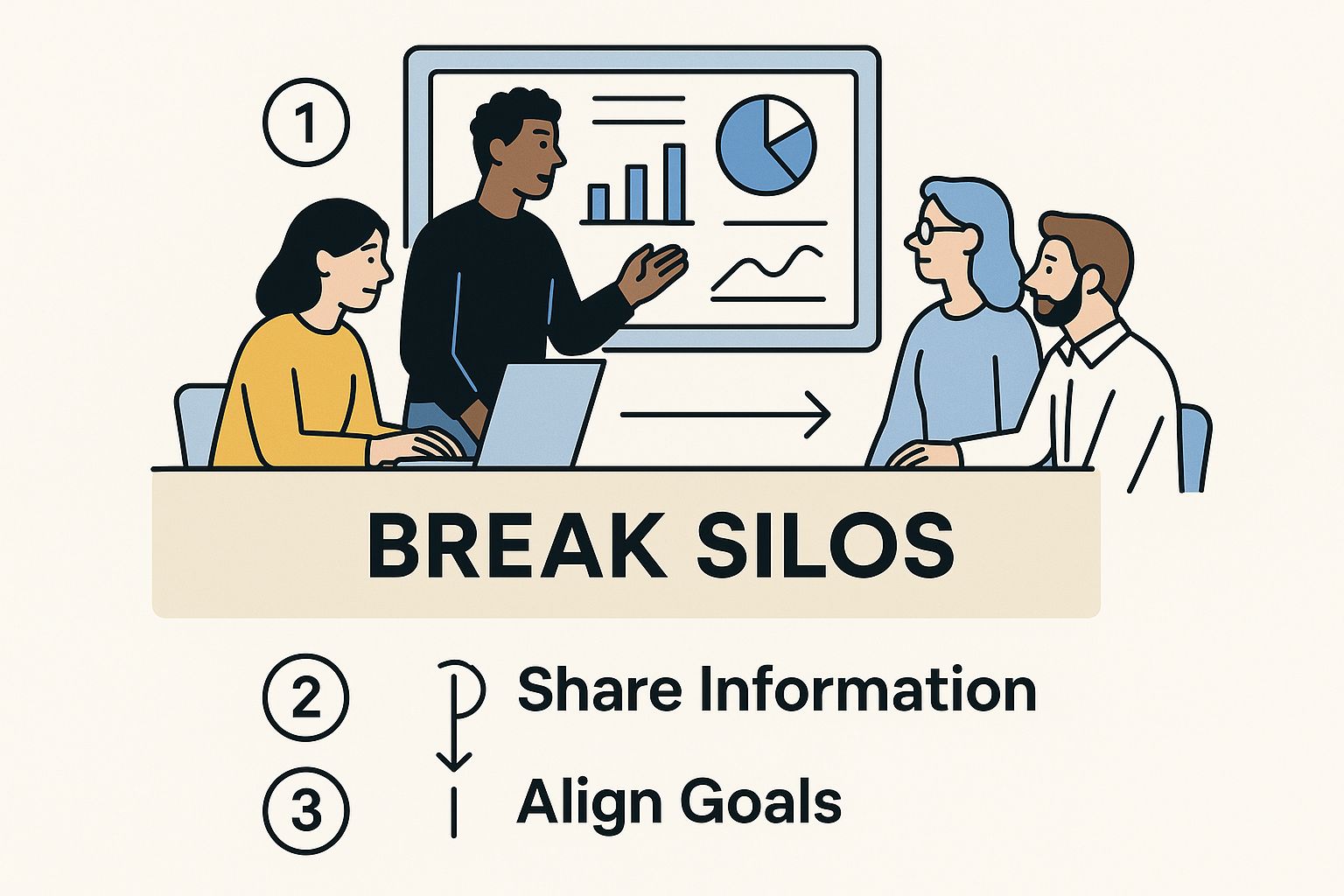To get rid of data silos, you first have to see them for what they are: a silent growth killer that fractures your business from the inside out. It’s about much more than just an IT headache. The real solution involves creating a unified data ecosystem through smart integrations and, just as importantly, building a culture where information actually flows between teams. This is how you get everyone—from sales to marketing to support—working from the same playbook.
Why Data Silos Are Killing Your Business
Let’s be honest. The term “data silo” sounds like jargon best left to the tech folks. But in reality, these isolated islands of information are actively sabotaging your bottom line, frustrating your teams, and creating some truly awful experiences for your customers.
They are the invisible walls that stop your company from ever seeing the full picture.

I’ve seen this happen more times than I can count. Your marketing team launches a brilliant campaign based on their customer engagement data. They see high open rates and click-throughs, so naturally, they double down on the ad spend.
Meanwhile, the sales team is working from a completely separate CRM. They’re dealing with customer feedback that directly contradicts everything marketing thinks they know. The result? A flawed campaign burning through cash because two teams couldn’t connect their data.
This isn’t just a minor inefficiency. It’s a massive strategic blind spot. When information is trapped, you end up with multiple, conflicting versions of the truth.
Disconnected data makes it impossible to understand the complete customer journey. This leads to wasted resources and missed opportunities. It’s the difference between making educated guesses and making genuinely smart decisions.
The True Cost of Data Silos
The problem isn’t just about internal friction; it has a monumental global impact. The financial toll of data silos is staggering. Research from IDC estimates these data prisons cost the world economy approximately $3.1 trillion annually. This loss comes from disconnected systems and incompatible data formats that torpedo productivity and innovation.
But the real cost of keeping these information barriers up goes far beyond the direct financial hit. It seeps into every corner of your operations, creating a domino effect of negative consequences. Understanding these specific symptoms is the first step toward finding a cure. If you’re looking for more hands-on ideas, our guide on breaking down silos in the workplace has some great starting points.
Here’s a look at how these symptoms typically show up and the damage they do.
| Silo Symptom | Business Impact |
|---|---|
| Fragmented Customer View | Sales, marketing, and support all have different puzzle pieces. No one sees the full picture, leading to generic and frustrating customer interactions. |
| Duplicate Work & Wasted Time | Teams spend hours hunting for information or manually fixing conflicting reports—time that should be spent on strategic, high-value work. |
| Inaccurate Business Reporting | Department leaders pull reports from different datasets. The C-suite gets a distorted view of performance, leading to flawed strategic planning. |
| Reduced Team Morale | Nothing kills motivation faster than hitting constant roadblocks. When people can’t get the data they need, frustration and distrust build up. |
Ultimately, these silos create a drag on the entire organization. They foster a culture of “us vs. them” between departments and prevent you from operating as a cohesive, data-driven unit. Recognizing these symptoms is the first critical step toward tearing down the walls.
Becoming a Data Detective in Your Company
Finding data silos isn’t just an IT problem; it’s a treasure hunt where the prize is your company’s untapped potential. To get there, you first have to put on your detective hat and start looking for the hidden traps where information gets stuck.
The signs are often hiding in plain sight. Do quarterly reports from sales and marketing ever tell conflicting stories? That’s a classic. Do you see a constant stream of requests for manual CSV exports just so one team can peek at another’s data? That’s a bottleneck begging to be fixed.
Sometimes, the clues are even sneakier. You might discover teams secretly using their own unsanctioned apps—so-called “shadow IT”—simply because the official systems don’t play nice with each other. This is a massive red flag. It creates yet another disconnected island of information that nobody else can even see, let alone use.
Charting Your Data Landscape
To really see what’s going on, you need to become a sort of “data cartographer,” mapping out how information flows through your organization. This means digging into where data lives, how it moves between teams, and—most importantly—where it hits a dead end.
This detective work has never been more critical. The global datasphere is projected to explode to over 175 zettabytes by 2025, with data volume doubling roughly every four years. You can read more about these staggering projections on data growth at OneData.ai. This data explosion makes it terrifyingly easy for critical information to get lost in isolated pockets.
A good starting point is to sit down with department heads and ask a few simple questions:
- What are your primary data sources? Get them to list out every tool and platform where they store critical information.
- How do you share data with other teams? Listen for tell-tale manual processes, like emailing spreadsheets or creating custom one-off reports.
- What data do you wish you had access to? This question is gold. It reveals the most painful information gaps holding them back.
Your goal isn’t just to find silos but to understand their real-world impact. Pinpoint the blockages that cause the most friction, delay the most projects, and cost your business the most money.
Your Diagnostic Checklist
As you interview teams, it helps to use a simple checklist to keep track of the common silo indicators. This isn’t just about making a list; it’s about organizing your findings so you can prioritize which walls to tear down first. Effective data mapping will almost always reveal messy inconsistencies, which is why following data cleaning best practices is such a crucial part of the journey.
Here’s what to look for:
- Inconsistent Metrics: When “customer acquisition cost” means one thing to marketing and something completely different to finance.
- Manual Data Entry: Teams wasting hours re-keying the exact same information into multiple systems. This is a massive time-sink.
- Delayed Reporting: It takes weeks to compile a comprehensive report because someone has to manually pull data from a half-dozen disconnected sources.
- Poor Customer Experience: A customer has to repeat their entire story to every support agent they speak with because their conversation history isn’t shared across the team.
By identifying these specific pain points, you move from talking about an abstract problem to creating a targeted action plan. You’ll have a clear map showing exactly where to begin.
Your Tactical Playbook for Tearing Down Walls
Ready for some strategic demolition? Getting rid of deeply embedded data silos isn’t a one-shot deal. It requires a multi-pronged attack. It’s not just about buying new software; it’s about fundamentally rewiring how information flows—or doesn’t flow—through your company.
The real goal here is to build a connected data ecosystem. One where every team, from sales to support, works from the same playbook.
This process kicks off with technology but is ultimately driven by strategy. The right tools build bridges between departments, turning isolated data puddles into a free-flowing river of insights. A classic pain point I see all the time is the disconnect between sales and marketing. Sales lives in a CRM like Salesforce, while marketing operates out of a platform like HubSpot. Without a bridge, they’re practically flying blind.
But when you connect those systems, that’s when the magic happens. Suddenly, a lead’s entire journey is visible, from the very first ad click to the final sale. Marketing finally sees which campaigns are driving actual revenue, not just vanity metrics. And sales gets crucial context on a prospect’s interests before they even pick up the phone.

As the image shows, breaking down silos is a team sport. It’s about combining technology and real teamwork to create a single, unified view of what’s going on. This really highlights that the solution isn’t just technical; it’s about bringing people and their data together around a central hub.
Create a Single Source of Truth
Integrations are a fantastic first step, but to truly eliminate data silos, you need to go bigger. You need a single source of truth (SSOT). This is your company’s central, undisputed data repository—often a data warehouse or a modern data lakehouse. Think of it as the ultimate reference library where every department checks out the same, up-to-date version of every book.
Creating an SSOT means pulling all your scattered data sources into one place. This is where the real work is, but the payoff is huge. One company I worked with merged their customer support tickets, sales data, and website analytics. For the first time ever, they could see the entire customer lifecycle.
The results were immediate and powerful:
- Customer Support: Agents could see a customer’s full purchase history and recent marketing interactions. This allowed them to provide faster, much more personalized support.
- Marketing Team: They discovered that customers who watched specific tutorial videos had a 30% higher lifetime value. This insight completely shifted their content strategy.
- Product Development: They pinpointed the features generating the most support tickets, which gave them a crystal-clear roadmap for improvements.
This 360-degree customer view didn’t just fix problems; it turned reactive teams into proactive strategists. As you build your own playbook, think about how these strategies contribute to enhancing decision making with in-depth business analytics and insights, turning raw data into an actual competitive advantage.
Charting Your Path Forward
Building this connected ecosystem is a massive part of any successful digital transformation. It takes careful planning and a clear vision for how data will fuel your business goals. For a deeper look into this process, check out this excellent guide on creating a modern digital transformation roadmap to help structure your efforts.
The ultimate goal is to make data accessible and useful for everyone. When information flows freely, you empower teams to collaborate effectively and make smarter, data-driven decisions that propel the entire organization forward.
Your playbook isn’t just about demolition. It’s about building something better in its place—a truly connected and intelligent enterprise.
Building Bridges with Smart Data Governance
Tearing down data silos is a huge win, but the real work starts after the walls come down. How do you keep them from creeping back up? Without a plan, teams naturally slip into old habits, and new, invisible walls start to form almost immediately.
The long-term answer isn’t a bunch of rigid, bureaucratic rules that nobody follows. It’s smart, agile data governance.
Think of governance less as a roadblock and more as the architectural blueprint for your company’s data. It’s a flexible framework that empowers your people, giving them the confidence to share and use information securely and effectively. This isn’t about locking data down; it’s about setting it free in a structured, trustworthy way.
This proactive approach is more critical than ever. Data silos are a stubborn, growing problem. A 2024 survey revealed that 68% of organizations now consider it their top data challenge—a huge jump from the previous year. Businesses are waking up to the fact that to get ahead, they need a strategy that covers not just cool integrations but also the nuts and bolts of governance and data literacy. You can dig into the specifics in the full 2025 data strategy trends report on Dataversity.net.
Establish a Cross-Functional Data Council
Your first move should be to pull together a cross-functional data council. And no, this is not just another IT committee. For this to work, you need representation from every corner of the business: marketing, sales, product, finance, operations—you name it.
Their mission is to champion collaboration and create a sense of shared ownership over the company’s data. This group becomes the central hub for all data-related decisions. It’s their job to hash out disagreements and make sure the rules work for everyone, not just one department. For instance, when marketing and finance can’t agree on what “customer acquisition cost” actually means, the council is the forum where they find that common ground.
The council’s core responsibilities should boil down to these:
- Defining a Unified Data Language: Create a universal business glossary so that key terms mean the same thing whether you’re in sales or support.
- Setting Access Policies: Establish clear, role-based rules for who can view, edit, and share different types of data.
- Championing Data Quality: Promote standards and best practices to ensure all shared information is accurate, consistent, and reliable.
Smart governance transforms data from a guarded asset into a shared utility. It builds the foundation of trust needed to truly eliminate data silos and prepare your organization for advanced analytics and AI.
Define Clear Standards and Policies
With the council in place, the next step is to write down the rules of the road. This means creating clear, simple documentation that a real human can understand and follow. Whatever you do, avoid creating a dense, 50-page manual that will gather digital dust. Focus on practical, actionable guidelines.
Start with the absolute basics. What do we mean by “customer data”? Who “owns” it? What are the approved tools for sharing it? Nailing down these definitions prevents the ambiguity that lets silos form in the first place.
From there, you can move on to access policies. A great real-world example is setting up permissions in a project management tool. A developer working on a feature might need full edit access to a project board. A stakeholder from the marketing team, however, probably just needs read-only access to check on progress. This small distinction ensures transparency without risking accidental changes or data breaches.
By establishing these standards, you create a system where sharing data is the default, not the exception. It gives employees the green light to find the information they need, confident they’re following the agreed-upon best practices.
Fostering a Culture of Data Collaboration
You can have all the best tools, integrations, and governance frameworks in the world, but they’re just the skeleton of a connected company. The real heart of the operation? Your culture. To permanently eliminate data silos, you have to win over the hearts and minds of your people. It’s about shifting the entire company’s mindset from “my data” to “our data.”

This is the human element, and it’s arguably the most challenging part of the puzzle. Technology is predictable; people, not so much. You can’t just send a memo and expect decades of departmental habits to disappear overnight.
True cultural change is built on demonstrating value, celebrating wins, and making data feel less like a chore and more like a superpower. It’s about empowering every single employee to use information with confidence.
Champion Success and Make It Visible
The fastest way to get buy-in is to show, not just tell. Find a cross-departmental project that knocked it out of the park because data was shared, and put that win on a pedestal. Maybe the marketing and sales teams finally synced their data, leading to a record-breaking quarter.
Don’t just mention it in a newsletter. Turn that success story into a company-wide case study. Interview the key players, highlight the specific insights they uncovered, and broadcast the results everywhere. When people see their colleagues getting praised for collaboration, they’re far more likely to get on board. These shared victories create powerful social proof.
Of course, these collaborative efforts need the right environment to flourish. To foster a culture of data collaboration, it’s essential to adopt strong meeting management best practices that ensure information flows freely and isn’t trapped in isolated discussions.
Make Data Literacy Accessible for Everyone
Data literacy shouldn’t be a skill reserved for your analysts and data scientists. In a modern company, it’s a core competency for everyone. But please, forget the dense, technical training sessions that put people to sleep.
Instead, offer accessible, role-specific data training that shows people what’s in it for them.
- For Sales Reps: Show them how to use marketing engagement data from a shared dashboard to prioritize their leads.
- For Support Agents: Teach them how to spot product issues by analyzing trends in customer tickets from the service desk.
- For Marketers: Train them to read the sales pipeline to better understand which campaigns are actually generating high-quality leads.
By democratizing data skills, you empower individuals to solve their own problems and find new opportunities. You’re creating a network of data champions across the entire organization, which is far more effective than any top-down mandate.
This cultural shift is ultimately built on a foundation of solid teamwork. If you’re looking for more ideas on getting your teams to work together more effectively, you might be interested in our guide on proven team collaboration strategies. Visionary leaders get it: a data-first mentality isn’t about control; it’s about empowerment.
Questions We Hear All the Time About Data Silos
Jumping into a project to tear down data silos always brings up a few common—and very valid—questions. Let’s tackle some of the biggest ones head-on. This should clear the air and help you set the right expectations for your data unification journey.
“Where on earth do I even begin?”
The first step is always discovery. You can’t fix what you can’t see. Before you even think about new software or processes, you have to become a data detective inside your own company.
Start by mapping out all your existing data sources. This isn’t a solo mission. Sit down with department heads and team leads. Ask them where their information actually lives, how they use it, and—most importantly—where the communication drops off. This audit is the bedrock of your entire strategy.
“Do I need to spend a fortune on software to fix this?”
Not necessarily, and definitely not right away. While powerful integration platforms and data warehouses are fantastic long-term goals, you can get some big wins by starting smaller. First, look for native integrations that might already exist in the tools you currently pay for. You might be surprised.
The key is to start with a clear strategy, not by throwing money at a new, shiny tool. I’ve seen it time and time again: better processes and a culture of sharing often make a bigger initial impact than any piece of expensive software.
“How do I get other departments on board?”
Ah, the million-dollar question. The answer lies in focusing on shared goals and what’s in it for them. Let’s be honest, nobody gets excited about a generic “IT project,” but they do get excited about hitting their targets faster and with less friction.
Frame the initiative around their specific wins. Show the sales team how unified data will help them close more deals. Demonstrate to marketing how it will directly boost campaign ROI. Prove to the support team how it will jack up their customer satisfaction scores.
Don’t go it alone. Create a cross-functional team from the very start. Giving every department a voice and a real stake in the outcome is the secret to turning skeptics into your biggest advocates.
“How long until we actually see results?”
You can score some impressive “quick wins” within just a few months. Tackling the most obvious and easy-to-fix integration points—like linking your CRM and marketing automation platform—often yields immediate, visible results that build momentum.
However, the larger, more fundamental changes take time. Building a full data warehouse and truly shifting the company culture toward data transparency can easily take a year or more. The good news? The small improvements you make along the way provide continuous and compounding value, so it’s a journey worth taking.
Ready to bridge the gap between your project management and development teams? resolution Reichert Network Solutions GmbH offers a seamless way to embed monday.com directly into Jira, eliminating one of the most common data silos for good. Create a single source of truth and drive real-time collaboration with monday.com for Jira.
